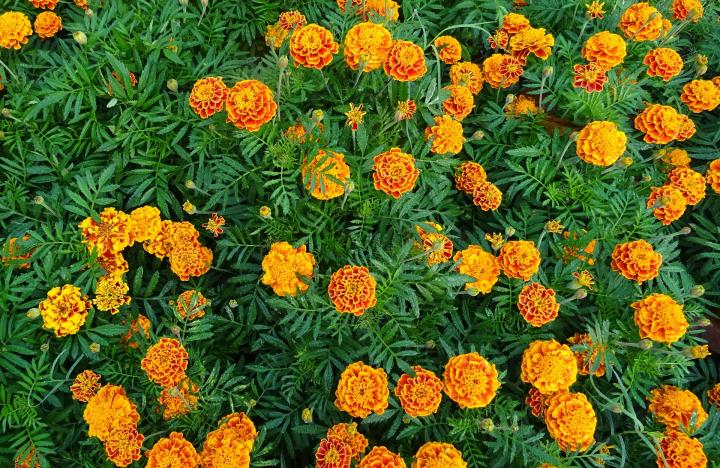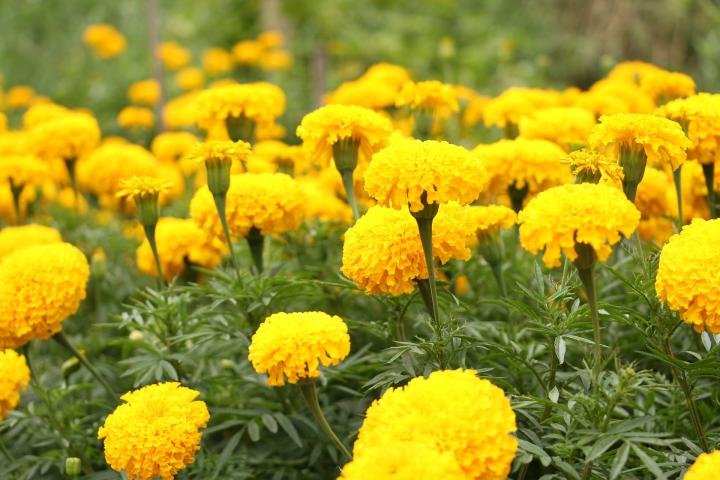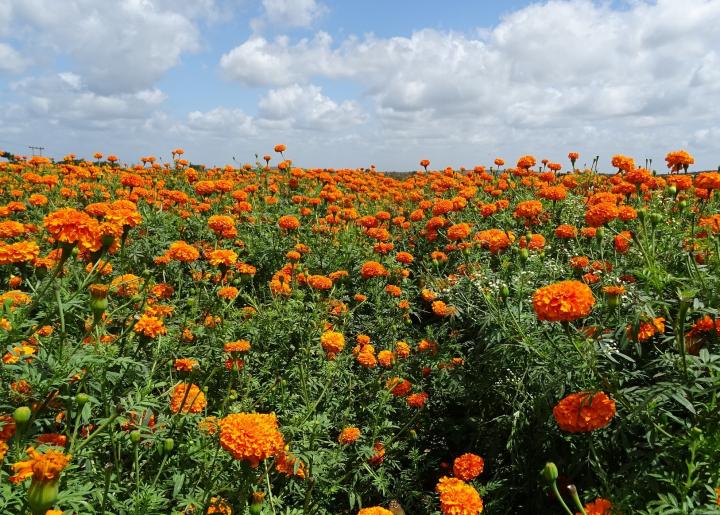
Photo Credit
Pixabay
Subhead
Sunshine on a Stem: Learn Why to Add These Sunny Blooms to Your Garden!
Read Next
Types
Marigolds have been stereotyped, but they offer tremendous variety. Both the American and French marigolds are generally aromatic, too, although some folks find the scent to be a bit overwhelming. Keep that in mind when choosing a planting site.
Marigolds have daisy- or carnation-like flower heads produced singly or in clusters. Although there are some 50 species, most we see in the garden are one of the following:
- Tagetes erecta (aka African marigolds, American marigolds, or Mexican marigolds): This species is the tallest and most upright marigold, reaching 3 to 4 feet in height and producing large, full flowers. According to Nate Dalman of the University of Minnesota Extension, “Despite the names, African marigolds did not originate in Africa and instead are called that because they were first imported to Europe via a trade route that passed through northwest Africa.” They’re native to Mexico and Central America and will thrive even under drought-like conditions.
- T. patula (aka French marigolds): This species tends to be smaller, bushier, and more compact than T. erecta. They are often wider than they are tall. Elegant and eye-catching, they have relatively demure flowers and usually grow from 6 inches to 2 feet tall. They are better suited to rainier conditions than the other Tagetes species.
- T. tenuifolia (aka signet marigolds): These petite marigolds do well in hot, dry sites and make for a beautiful edging plant. They rarely reach more than a foot in height.
French Marigolds (T. patula)
- ‘Little Hero’ Series: 7-inch-tall plants with large, double carnation flowers in 7 color combinations of maroon, orange, and yellow.
- ‘Hero’ Series: 10-inch-tall plants with double carnations, large (2-inch-wide) flowers in 7 different combinations of yellow, orange, and maroon.
- ‘Bonanza’ Series: 2-inch-wide, double carnation flowers in 5 different combinations of yellow, orange, and maroon on bushy, compact 8-inch-tall plants.
- ‘Aurora’ Series: 1-foot-tall plants with wide-petaled, anemone-like flowers in shades of maroon, yellow, and orange.
- ‘Janie’ Series: Early blooming. 8-inch-tall plants are perfect for container growing. Double carnation type flowers in 6 different combinations of yellow, orange, and maroon.
- ‘Boy O’ Boy’ Series: 6-inch-tall prolifically flowering plants with flowers in shades of maroon, yellow, and orange

American/African Marigolds (T. erecta)
- ‘Jubilee’ Series: 2-foot-tall plants with dense, double flowers in shades of yellow and orange.
- ‘Gold Coin’ Series: 1½- to 2-foot-tall plants with large (5-inch-wide) double blooms in gold, yellow, and orange.
- ‘Safari’ Series: 1-foot-tall plants with flat-topped, large flowers in shades of maroon, yellow, and orange.
- ‘French Vanilla’: 3-inch-wide flowers are pure creamy white. Minimal scent. Plants are 1½ to 2 feet tall.
Where to Buy Marigolds
Gardening Products
Comments
My marigold plant leaves are drying even before flowering.
Can you suggest me the remedy?
I planted my marigolds in April. They are in a pot as I do not have a garden. They grew quite nicely over 1 foot tall but it is now july 4th and they have yet to produce a flower. What am I doing wrong?
I bought some 10 cent packs...flowers grew in a few places, but those have gone wild-doubling every week
Is it a good idea to pinch out the first flowerhead of a French Marigold plant to encourage the plant to bush out and produce even more flowers? My husband bought several and planted them in our garden but I don't want to pinch out the flowerheads just in case I'd be doing the wrong thing.
My Marigolds get full sun, nice, but average soil, have had lots of water but good drainage and have been planted 4 weeks but not even the buds present when we planted have bloomed as the plants have not grown a bit and might be starting to die. Suspended animation. I did add crushed brick on top about 10 years ago and have not had a good crop since. Did I destroy the PH or something? Last year we redid the top with cedar bark. We love marigolds and am very disappointed.
Marigolds really aren't fussy about soil and, in fact, can thrive in poor soil as long as there is good drainage (which you say they have). It's fine to use cedar bark as a mulch on the soil surface. It doesn't dramatically change the pH (nor does crushed brick). We don't, however, recommend incorporating wood/bark chips into the soil itself or in cultivated soil and seed beds as it can create a nitrogen deficiency and decrease soil oxygen levels.
Do you have high heat this year? That is often a reason for lack of bloom. If so, we'd recommend 2 to 3 inches of organic mulch to keep in the moisture.
Otherwise, do you see any wilting of the foliage, discolored spots, or a coating of mildew? This indicates one of several fungal infections. Take a sample to your local cooperative extension for a diagnosis.
- « Previous
- 1
- 2
- …
- 10
- Next »











It depends on the size. When sprouts are a few inches tall, you thin them by pulling up the weaker, overcrowded ones, to allow space for the remaining ones to grow. However, once they are grow, we do not recommend tearing them apart. When we plant in pots or cups (versus the ground), we use a "soilless potting mix" not garden soil. If it was soil, we would simply mix in organic matter such as compost, but container mix isn't soil so you do want to add in some fertilizer. Ask your garden center. Water them regularly as pots or cups tend to dry out more quickly than soil.